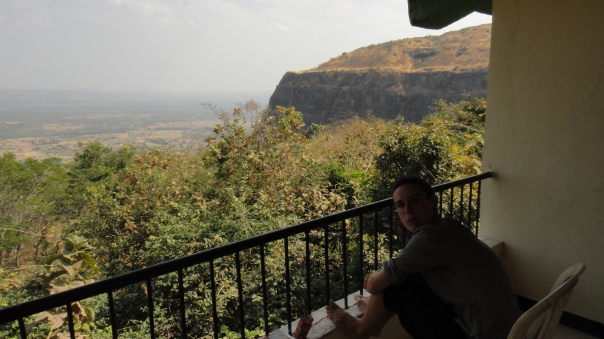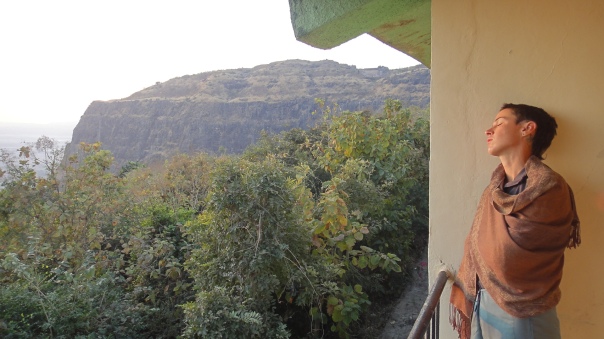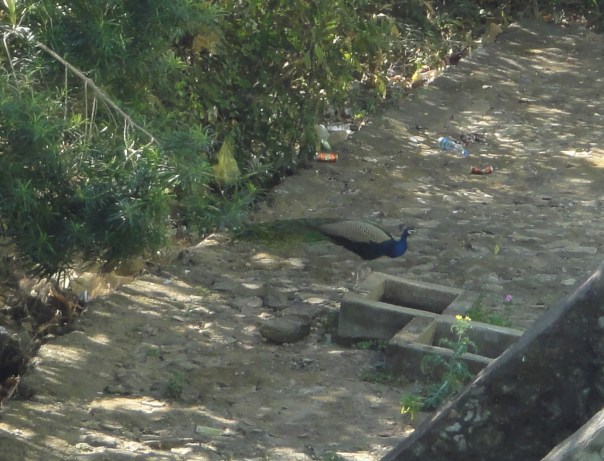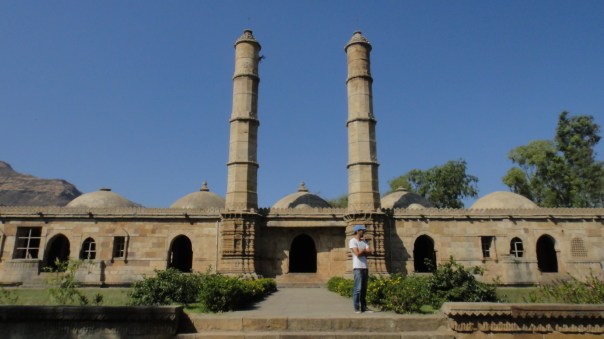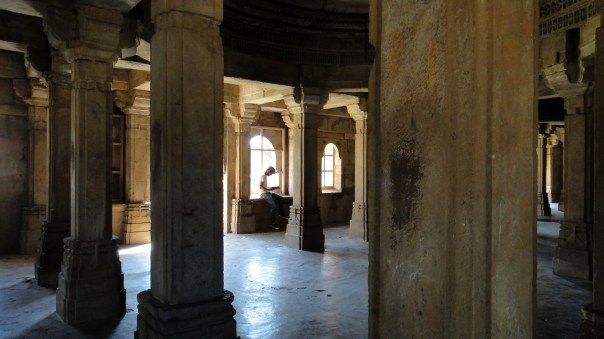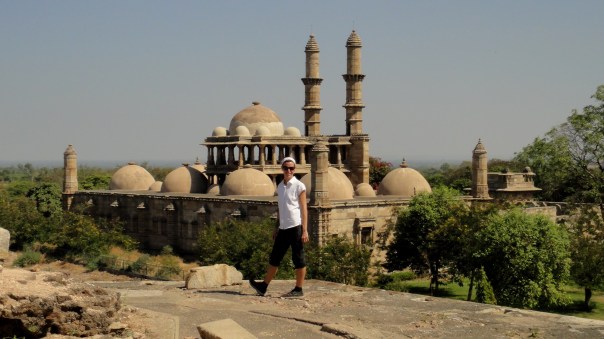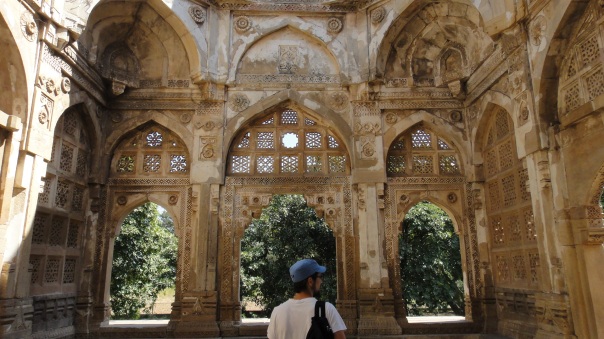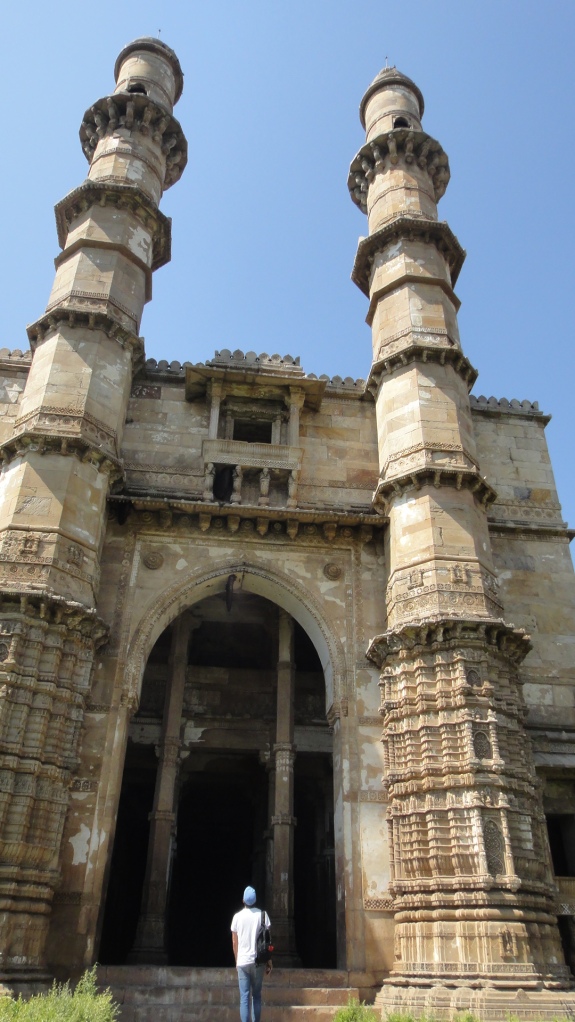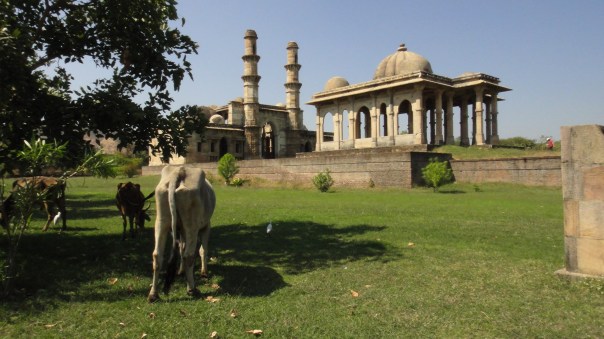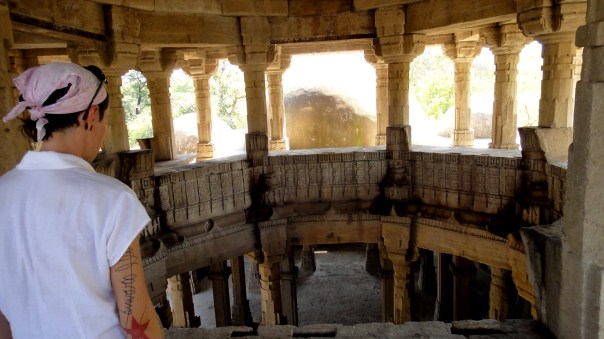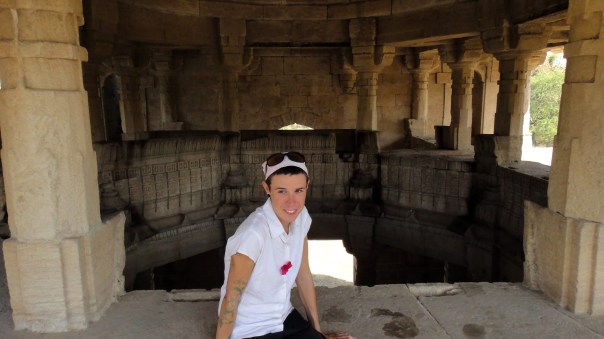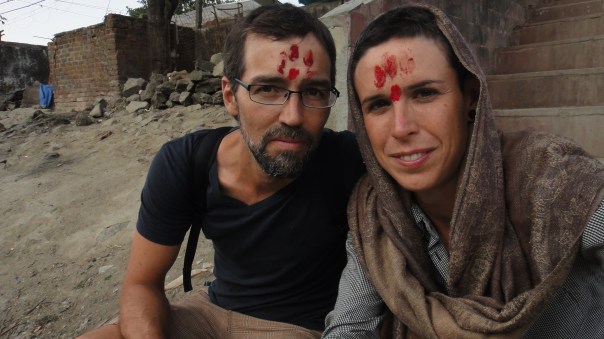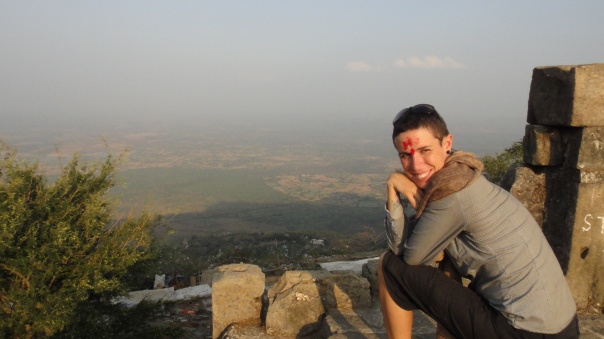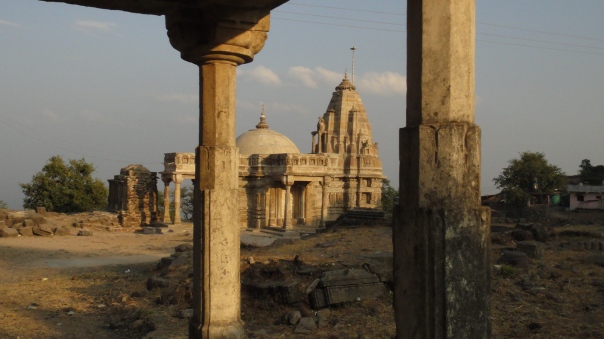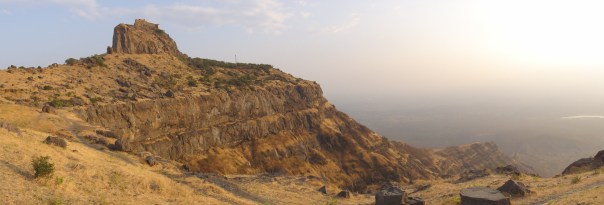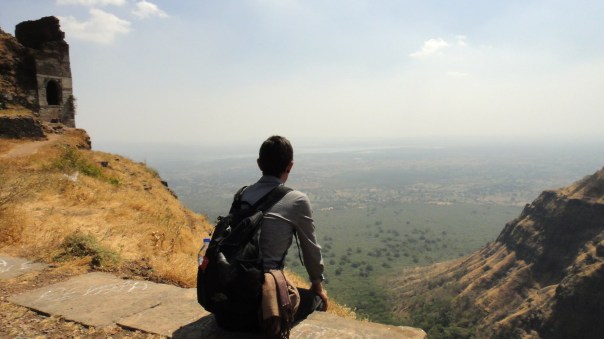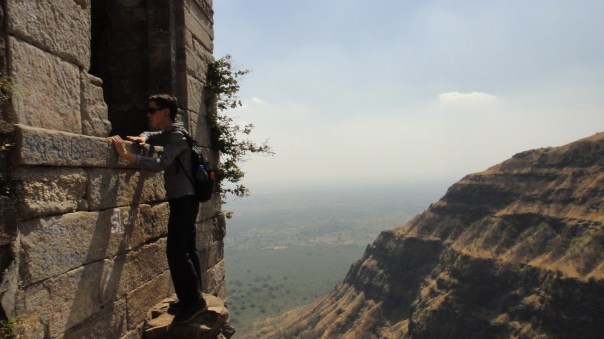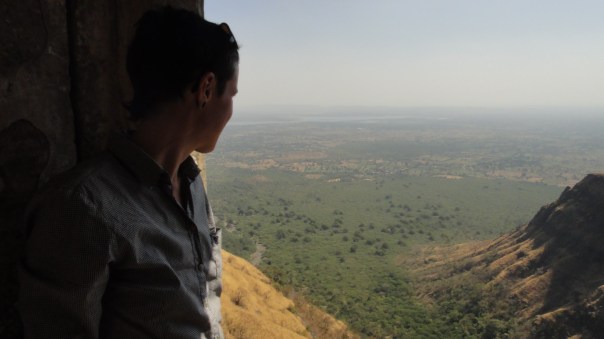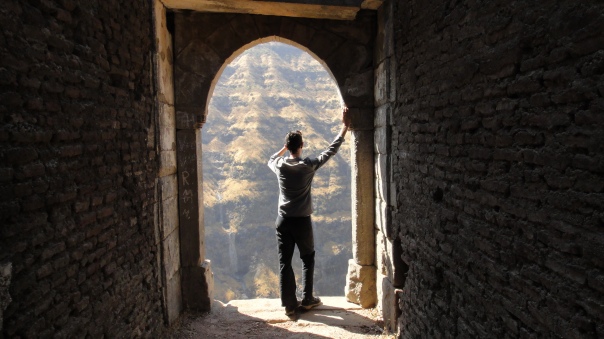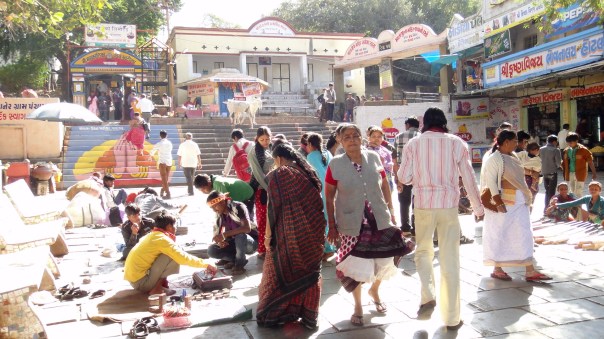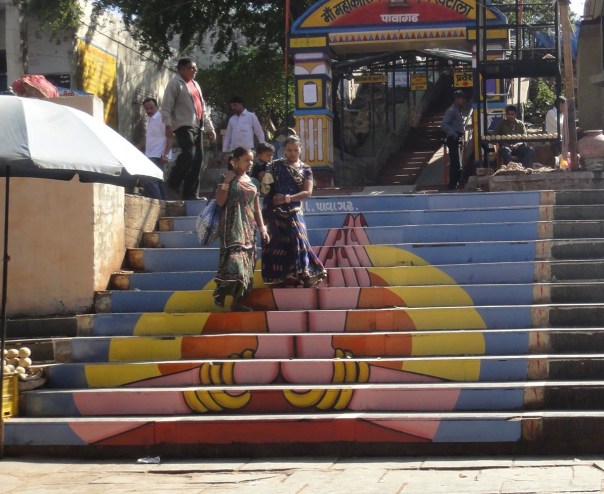We arrived in Champaner and Pavagadh and checked in to the Champaner Hotel, a dingy state-run joint with lots of elbow grease, borderline psychotic staff, and the best balcony ever.
I would sit here for hours, under the pretense of working on my Hindi, simply staring out at the grand grand view in the distance, or else focusing in on the treetops immediately in front of me. The balcony was at the perfect height to observe the many different types of birds that lived in the forest (See Birds of Gujarat entry, coming), and was actually one of the best bird watching locations of the trip so far! Peering over the rail, we would frequently see pairs of brilliant wild peacocks walking along the forest edge. I started compulsively going to the balcony and looking down to see if any peacocks were there. Further out, the view went down the hill and encompassed miles and miles of agricultural land to the hills in the far distance. Whereas in Goa, we had always faced west, here we faced east, and so instead of sunsets, we began having regular sunrise sessions. It is nice here in India right now, because the sun doesn’t rise until 7:15 or 7:30. This makes sunrises much easier to catch, and also makes for less tiring dawn birding walks.
When we weren’t sitting spellbound on the balcony, we were wandering around the stunning ruined site that is here. The Unesco World Heritage Site of Champaner and Pavagadh. Pavagadh is a sacred 762m volcanic hill, a total anomaly in flat, flat Gujarat. Next door, at the foot of the hill, Champaner is a ruined Gujarati capital. Pavagadh is thought to have been fortified as early as the 8th Century, and became the capital around 1300. In 1484, it was taken siege for 20 months, which ended with the population’s committing jauhar, ritual mass suicide, in the face of defeat. The conquering Muslim ruler began a new capital, Champaner, at the foot of the hill, and filled it with a pile of spectacular mosques and other types of architecture. But the city only lasted 40 years or so before being in turn by Mughals in 1535, whereupon it was deserted and fell into ruin. The rest of this city has basically disappeared, which means that we would walk through the jungle for 30 minutes and then suddenly come upon a huge mosque, just sitting there rotting in the middle of the forest. Another half hour of bushwacking and -boom- another extraordinary piece of architecture. Pretty darn cool.
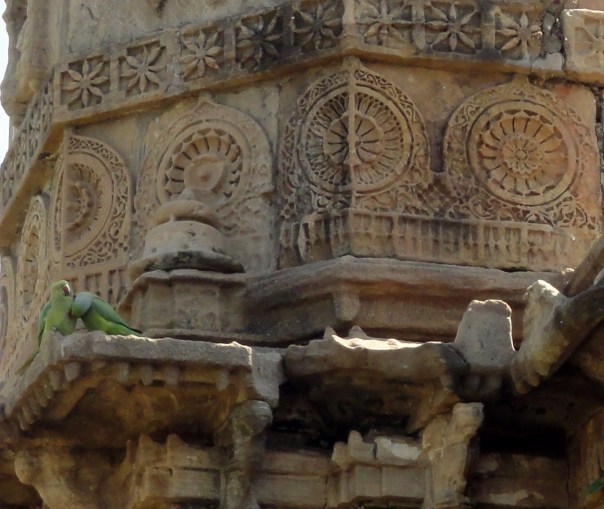 Rose-ringed Parakeets – Psittacula krameri – ‘One of the most prolific parrots on earth and able to establish feral populations very quickly.’ As you can see, they tend to do a lot of lovey-dovey snuzzling together.
Rose-ringed Parakeets – Psittacula krameri – ‘One of the most prolific parrots on earth and able to establish feral populations very quickly.’ As you can see, they tend to do a lot of lovey-dovey snuzzling together.
The above are all pictures of Champaner, the ruined Muslim city at the bottom of the hill.
Up above, Pavagadh mountain has only a small temple at the top, but Hindu and Jain pilgrims come in flocks to climb to the top, which takes a couple hours, and it was really nice to go with them. We went a good part of the way up by cable car on ‘India’s Most Modern Ropeway’. The views from the top were just outstanding. Because this hill is surrounded by completely flat land, you really can see for miles and miles in every direction. Some people find god in temples, some of us find it in expansive views…
On the way down, rather than using the return ticket for the ropeway, we walked the stairs, which gave us total jelly legs, but also a chance to explore more views and the many more ruins scattered over the face of the hill which don’t seem to get a lot of attention, but which were really beautiful too.
 Riding up Pavagadh on India’s Most Modern Ropeway. I would admittdly feel a slight bit more comfortable if they would call it ‘cable’ instead of ‘rope’.
Riding up Pavagadh on India’s Most Modern Ropeway. I would admittdly feel a slight bit more comfortable if they would call it ‘cable’ instead of ‘rope’.
The Karma-wallas got us !
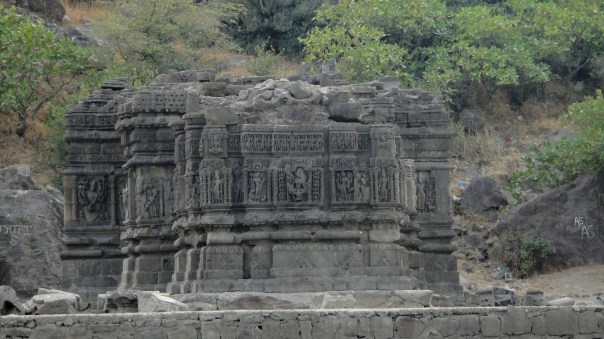 I wish we hadn’t lost the art of stone carving in our architecture!
I wish we hadn’t lost the art of stone carving in our architecture!
 Ruins on the way back down, with the summit of Pavagadh in the background.
Ruins on the way back down, with the summit of Pavagadh in the background.
 I think this picture gives a good idea of the scale.
I think this picture gives a good idea of the scale.
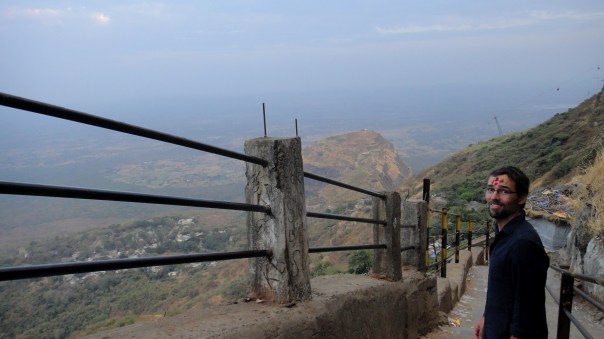 The pilgrim path. We walked down, but many female pilgrims come here for a day and RUN up and down as many times as they can, without taking any food or water.
The pilgrim path. We walked down, but many female pilgrims come here for a day and RUN up and down as many times as they can, without taking any food or water.
This is the little ‘town’ at Pavagadh. The guys crouching on the left are giving tattoos to the pilgrims for .40 cents. People line up and take turns getting the OM symbol or a loved one’s name tattooed on their bodies with the same tattoo gun that everyone else is using. Even really traditional-looking women were having it done. I found it completely fascinating and spent quite a bit of my time hanging around and watching.
It was really hard to pull ourselves out of here, but e a week later, we got a ride back to Baroda and caught a train up to the capital Ahmadabad. We had planned to spend the night here, and then get a train further south to Shatrunjaya, another sacred mountain, which apparently has a sea of over 800 temples on the top. We were then planning to go to Girnar Hill for another hill-top pilgrimage, and to attend the Bhavnath Mela, a religious fair that draws throngs of nagas (those most fascinating of all sadhus (spiritual men), the naked, ash covered ones.
Once in Ahmedabad, however, a combination of various travel and accommodation complications led us to decide on the spot to skip these other Gujarati sites and to book a train directly to Mount Abu in Rajasthan for two days later.
